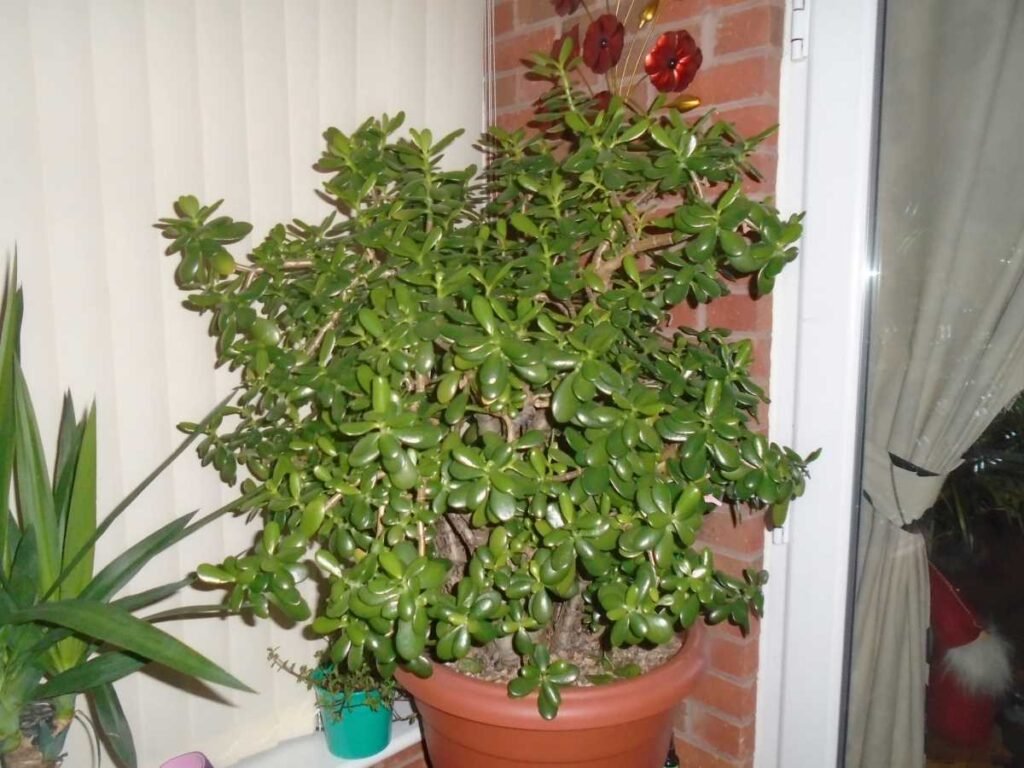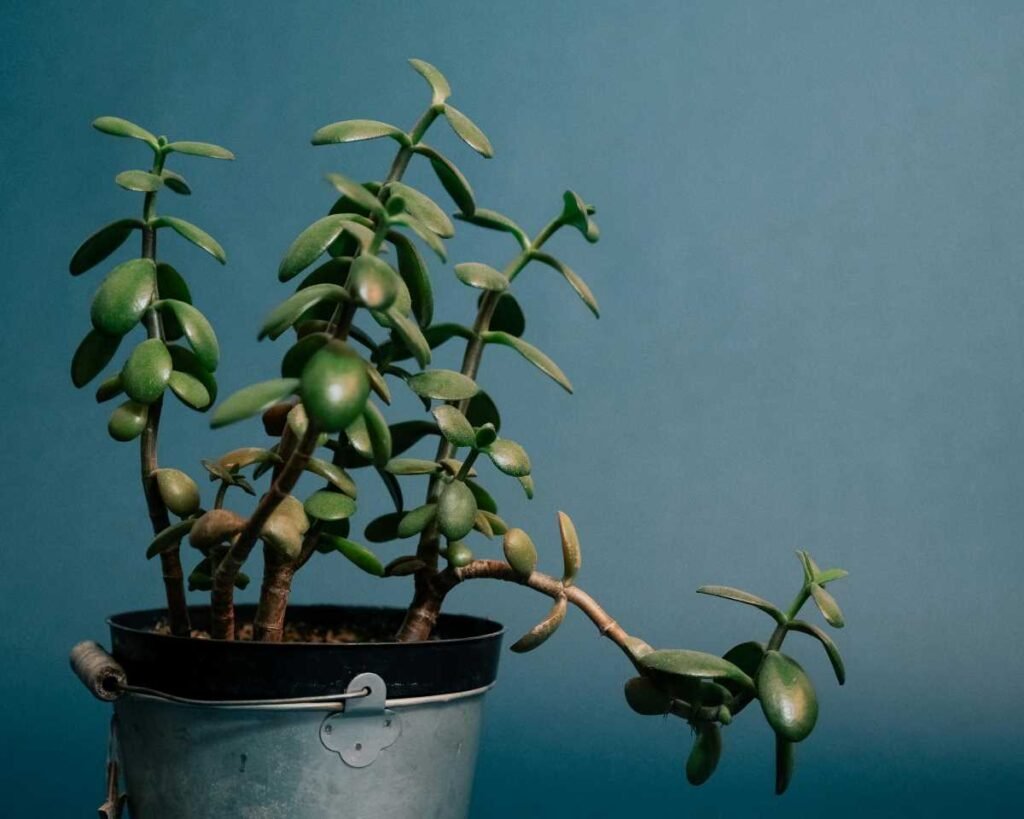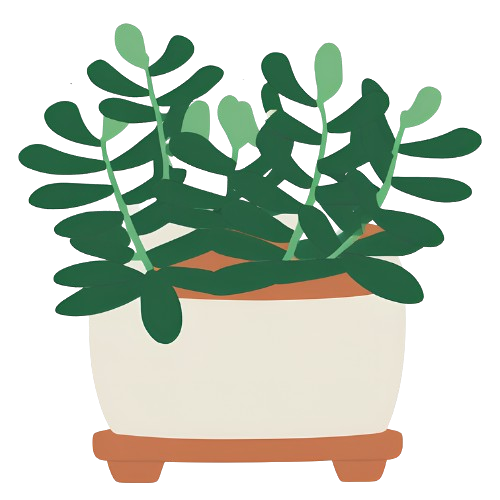Have you just got a jade plant? Or maybe you’ve had one for a while but it’s not growing well? The spot you pick for your jade plant can make all the difference. These hardy plants bring good luck and clean air to your home. But they need the right place to truly thrive.
In this guide, I’ll share all the best spots for your jade plant. We’ll look at light needs, room choices, and feng shui tips. You’ll learn how to pick the perfect place for a happy, healthy jade plant that grows for years to come.
Table of Contents
Why Jade Plant Placement Matters

Where you put your jade plant affects how well it grows. Jade plants come from sunny parts of South Africa. They grow in dry, rocky areas with lots of light. In our homes, we need to find spots that match these conditions as closely as we can.
The right spot gives your jade plant what it needs to stay healthy. Good placement helps with:
- Getting enough light
- Staying at the right temperature
- Having good air flow
- Being safe from pets and kids
- Bringing good luck (if you follow feng shui beliefs)
Let’s dive into all the things to think about when finding the perfect home for your jade plant.
Light Needs for Jade Plants
Light is the most vital thing to think about when placing your jade plant. These plants love bright light. They need at least 4 hours of direct light each day to stay healthy.
The best windows for jade plants are:
South-facing windows: These get the most light all day and are often the top choice for jade plants. In summer, you might need to move the plant back a bit or add a sheer curtain to prevent leaf burn.
East-facing windows: These provide gentle morning sun and bright indirect light for the rest of the day. This is a great choice for jade plants, as the morning sun isn’t too harsh.
West-facing windows: These windows get hot afternoon sun. Jade plants can do well here, but might need to be placed a foot or two away from the glass to avoid too much intense light.
North-facing windows: These get the least light. Jade plants can survive here but won’t thrive unless you add a grow light. If a north window is your only option, place the plant as close to the glass as you can.
If your jade plant doesn’t get enough light, it will grow long, skinny stems as it stretches toward the light. The leaves might also be smaller and paler than they should be.
On the flip side, too much harsh light can burn the leaves, causing brown spots. If this happens, just move your plant a bit further from the window or add a thin curtain to filter the light.
Best Rooms for Jade Plants
Now that we know about light needs, let’s look at which rooms in your home might work best for jade plants.
Living Room Placement
The living room is often a great spot for jade plants. Here’s why:
- Living rooms often have big windows with good light
- The temp is usually stable and comfortable
- You’ll see and enjoy your plant daily
- Feng shui experts say jade plants in living rooms bring wealth
Good spots in the living room include:
- On a table near (but not right against) a sunny window
- On a plant stand in a bright corner
- On a shelf that gets good light
Just keep jade plants away from drafty doors, heating vents, or air conditioners that might shock them with sudden temp changes.
Kitchen Placement
Kitchens can be good spots for jade plants if they get enough light. Benefits of kitchen placement include:
- Many kitchens have bright windows over sinks
- The higher humidity from cooking and washing can be good
- You’ll see your plant often as you cook and clean
Good kitchen spots include:
- A bright windowsill (if it’s wide enough)
- On a counter near a window
- On top of a fridge near a window (if your fridge doesn’t get too hot)
Just keep your jade plant away from the stove, as cooking heat and grease can harm it. Also, make sure it’s not in the way of your food prep areas.
Bedroom Placement
Jade plants can work well in bedrooms too. Here’s why you might want one there:
- They release oxygen and can help clean the air
- They have a calm, soothing look that fits bedroom decor
- Feng shui says they promote restful sleep and good health
Good bedroom spots include:
- On a dresser near a window
- On a bedside table (if the light is good)
- On a desk that gets ample sun
Avoid putting jade plants directly over your bed, as they have woody stems that could drop leaves. Also, some people don’t like plants in bedrooms. But this is just a personal choice—jade plants are safe in bedrooms.
Office or Study Placement
Your home office or study can be a great place for a jade plant. Here’s why:
- The plant can help clean the air while you work
- The green color may help reduce eye strain from screens
- Feng shui experts say jade plants boost brain power and focus
- The plant adds life to what might be a dull work space
Good office spots include:
- On your desk near a window (but not blocking your view)
- On a shelf above your desk that gets good light
- On a file cabinet near a bright window
Just make sure your plant isn’t too close to electronics that might get hot, and that it won’t get knocked over when you reach for books or supplies.
Bathroom Placement
Bathrooms are not ideal for jade plants. Here’s why:
- Most bathrooms don’t get enough light
- The high humidity can cause root rot
- Temperature swings from hot showers might stress the plant
If your bathroom has a very bright window and good air flow, you might be able to keep a jade plant there. But in most cases, it’s better to choose a different room.
Feng Shui Placement for Jade Plants
Many people place jade plants based on feng shui beliefs. In feng shui, jade plants are thought to bring wealth, prosperity, and good luck. Here are the best feng shui spots for your jade plant:
Southeast Corner
The southeast area of your home or a room rules wealth and money in feng shui. Placing a jade plant here is said to boost your financial luck. This is probably the most popular feng shui spot for jade plants.
East Area
The east area stands for family and health. A jade plant here is thought to promote family well-being and growth.
Money Areas
Besides the southeast, you can place jade plants in other “money areas” of your home:
- Near the front door to welcome wealth into your home
- In your home office to bring success in business
- On your desk (on the far left corner, which is the wealth corner)
Placement Tips for Good Feng Shui
For the best feng shui energy, follow these tips:
- Use a round pot (round shapes represent coins in feng shui)
- Choose a red, purple, or green pot (colors of prosperity)
- Make sure the plant is healthy with plump leaves
- Keep the plant clean and dust-free
- Never place jade plants in bathrooms or bedrooms according to strict feng shui rules
- Avoid placing the plant directly under a beam
- Don’t place jade plants in groups of four (the number four is considered unlucky in Chinese culture)
Even if you don’t believe in feng shui, these placement ideas often put your jade plant in spots with good light and energy flow, which helps it thrive.
Safe Placement Away from Hazards

When placing your jade plant, think about safety—both for the plant and for people and pets in your home.
Keep Away from Pets and Children
Jade plants are toxic if eaten. They can cause upset stomachs, vomiting, and lethargy in pets and children. Place jade plants:
- On high shelves out of reach
- In rooms pets can’t access
- In hanging planters (if you have good light from above)
- Behind baby gates or pet barriers
If you have curious cats that climb, you might need to keep jade plants in rooms the cats don’t enter.
Avoid Extreme Temperatures
Jade plants like stable temps between 65-75°F (18-24°C). Avoid placing them:
- Near heating vents or radiators
- Next to air conditioners
- In drafty spots near doors or windows
- On cold windowsills in winter
- In unheated rooms
A good rule is: if you feel too hot or cold in a spot, your jade plant probably will too.
Protect from Physical Damage
Jade plants have brittle stems that can break easily. Avoid places where they might get bumped, such as:
- High-traffic areas
- Narrow hallways
- Near doors that swing open
- On wobbly tables or stands
- Where they might be knocked by curtains or blinds
If a stem does break, don’t worry too much. You can often root the broken piece to start a new plant!
Containers and Stands for Jade Plants
The container you use can affect where you can place your jade plant. Here are some things to think about:
Pot Size and Weight
Jade plants need pots with good drainage. As they grow, they get top-heavy. This means:
- Use a heavy pot that won’t tip over
- Pick a pot that’s wide at the base
- Choose a pot just 1-2 inches wider than the root ball
- Make sure the pot has drainage holes
A heavy ceramic or terra cotta pot often works best for jade plants. These pots are stable and also help wick away extra moisture.
Plant Stands and Shelves
If you don’t have much free space on tables or counters, use plant stands or shelves:
- A sturdy plant stand can place your jade at the perfect height near a window
- Floating shelves installed near windows make great plant perches
- Window shelves that attach to the sill can hold small jade plants
- Plant carts with wheels let you move your jade to follow the sun
Just make sure any stand or shelf is strong enough to hold the plant as it grows. Jade plants get quite heavy over time!
Window Options
If your windowsills are too narrow for pots, try these options:
- Window shelves that attach to the frame
- Suction cup window planters (for small jade plants only)
- Hanging planters that can be hung from curtain rods
- Plant stands placed right next to the window
Seasonal Changes in Placement
You might need to move your jade plant as the seasons change. Here’s how to adjust:
Summer Placement
In summer, the sun is stronger and days are longer. You might need to:
- Move plants back from south and west windows
- Add sheer curtains to filter intense light
- Move outdoor jade plants to spots with afternoon shade
- Water more often in hot, bright spots
Winter Placement
In winter, light levels drop and heating systems run. You might need to:
- Move jade plants closer to windows
- Shift plants to south-facing windows if possible
- Keep plants away from cold drafts and heating vents
- Water less often
- Add a grow light if natural light is very low
Spring and Fall
Spring and fall are often the best times for jade plants. The light is bright but not too intense. During these seasons:
- South and east windows are usually perfect
- Plants can often handle more direct sun
- It’s a good time to move plants outside if you want
- Growth is often at its best
Multiple Jade Plants: Creating Arrangements
If you have more than one jade plant, you can create lovely groupings. Here are some ideas:
Grouping by Size
Create a display with plants of different sizes:
- Place larger jade plants at the back
- Put medium plants in the middle
- Set small plants at the front
- This creates a “family” look that many find appealing
Grouping with Other Plants
Jade plants look great with other succulents:
- Group with aloe, echeveria, or haworthia
- Use plants with similar light and water needs
- Create contrast with different colors and shapes
- Just make sure all plants in the group need similar care
Spacing Considerations
When grouping plants:
- Leave enough space between them for air flow
- Make sure all plants can get enough light
- Don’t crowd them too tightly, as this can lead to pest problems
- Allow room for growth
Moving Jade Plants Outdoors Seasonally
Many jade plant owners move their plants outside during warm months. If you try this:
Outdoor Placement Tips
- Start in a shady spot and slowly move to more sun
- Morning sun with afternoon shade often works best
- Protect from strong winds that can break stems
- Keep away from areas where pets or wild animals might nibble
- Make sure the pot is stable and won’t blow over
- Bring plants in when temps drop below 50°F (10°C)
Transitioning In and Out
When moving jade plants between indoors and outdoors:
- Make the change slowly to avoid shock
- Start with just a few hours outside in a sheltered spot
- Gradually increase outdoor time over 1-2 weeks
- Do the same in reverse when bringing plants back inside
Special Placement for Sick or Struggling Plants
If your jade plant isn’t doing well, a change of place might help:
Recovery Spots
For sick or weak jade plants:
- Place in bright indirect light rather than full sun
- Keep at a stable temperature
- Isolate from other plants if you suspect pests
- Put in a quiet, low-traffic area
- Keep away from drafts and heat sources
Propagation Stations
If you’re growing new jade plants from cuttings:
- Place in bright but indirect light
- Keep away from cold drafts
- Choose a warm, humid spot
- Keep soil lightly moist until roots form
Best Places for Different Jade Plant Varieties
Different types of jade plants may do better in slightly different spots:
Standard Jade (Crassula ovata)
The common jade plant likes:
- Bright light with some direct sun
- Stable temperatures
- Good air flow
Variegated Jade
Varieties with white or cream patches need:
- More overall light (they have less green to photosynthesize)
- Protection from harsh afternoon sun (the white parts burn easily)
- East windows are often perfect for these
Miniature Jade Varieties
Smaller jade varieties work well:
- On desks or small tables
- In dish gardens
- On narrow windowsills
- In small spaces where regular jades would be too big
Common Placement Mistakes to Avoid
Many jade plant problems come from poor placement. Here are common mistakes:
Too Little Light
Signs your jade isn’t getting enough light:
- Long, skinny stems
- Pale, small leaves
- Leaning strongly toward light
- Slow or no growth
- Dropping leaves
Too Much Heat
Too much heat can cause:
- Wrinkled leaves
- Brown, dry leaf edges
- Soft, mushy stems (if combined with high humidity)
- Soil that dries out too quickly
Unstable Conditions
Jade plants don’t like frequent changes:
- Avoid spots with big temperature swings
- Don’t keep moving the plant around
- Don’t place near doors that open and close often
- Avoid areas with strong air currents
Overcrowding
Jade plants need their space:
- Don’t crowd with other plants
- Make sure air can circulate around the plant
- Give room for the plant to grow
- Don’t place too close to walls or other objects
Creative Placement Ideas
Want to make your jade plant a real focal point? Try these creative ideas:
Elevated Displays
- Place on a tall plant stand to create height variety
- Use wall-mounted shelves to create a green wall effect
- Try a hanging macramé holder for small jade plants
- Use stepped shelves to display multiple plants at different heights
Themed Groupings
- Create a “money corner” with jade and other lucky plants
- Make a succulent garden with jade as the centerpiece
- Group plants with similar colors or shapes
- Create a zen-inspired display with jade, rocks, and sand
Decorative Accents
- Add small decorative stones on top of the soil
- Place the pot on a decorative tray with pebbles
- Use a cache pot (decorative outer pot) that matches your decor
- Add tiny decorative items like mini garden ornaments
Monitoring Your Jade Plant After Placement
After you find a spot for your jade plant, keep an eye on it:
Watch for Signs of Happiness
A happy jade plant will show:
- Firm, plump leaves
- Rich green color (or proper variegation if it’s a variegated type)
- Compact growth
- New leaves forming
- Sturdy stems
Watch for Signs of Stress
Look for these warning signs:
- Leaning or stretching toward light
- Yellowing or browning leaves
- Soft or shriveled leaves
- Leaf drop
- Slow growth or no growth
If you see these signs, try a different spot. Small changes can make a big difference!
Jade Plant Placement Through the Years
As your jade plant grows, its placement needs might change:
Young Plants
Small, young jade plants:
- Can fit on narrow windowsills
- Need a bit more care and attention
- Often benefit from slightly more humidity
- May need closer monitoring for water needs
Mature Plants
Older jade plants:
- Get heavy and need sturdy surfaces
- May need larger, heavier pots for stability
- Might need pruning to control size
- Create more visual impact and can be focal points
Heirloom Plants
Very old jade plants:
- Can become tree-like and need very stable placement
- May need special supports for heavy branches
- Become true family treasures
- Deserve places of honor in your home
Final Thoughts on Jade Plant Placement
Finding the right spot for your jade plant might take some trial and error. Don’t worry if your first choice isn’t perfect. These tough plants can handle some adjustments.
The key things to remember are:
- Light is most important—aim for bright light with some direct sun
- Keep your plant at a steady temperature
- Make sure the pot is stable
- Keep away from curious pets and children
- Consider feng shui if that interests you
- Be ready to make seasonal adjustments
With good placement, your jade plant can grow for decades, even becoming a family heirloom to pass down. Take time to find that perfect spot, and your jade plant will reward you with years of lush, green growth and maybe even delicate star-shaped flowers!
Happy jade plant growing!

My name is Shahriar Robin, and I’m the creator of JadePlants.org. Growing up in a village, I developed a deep connection with nature from a young age. Plants and gardening have always been a part of my life, and jade plants, with their resilience and elegance, have held a special place in my heart. Over the years, I’ve learned so much about these fascinating plants, and I created this site to share that knowledge with you—completely free of charge.

